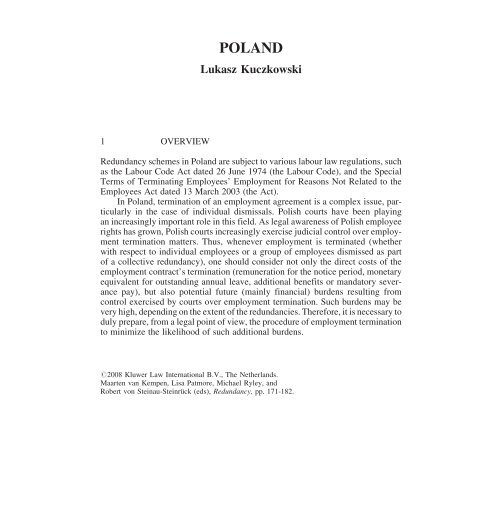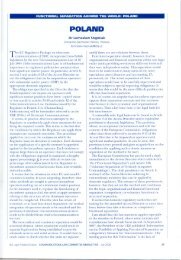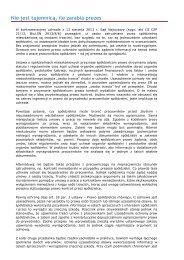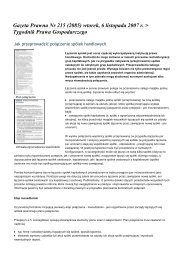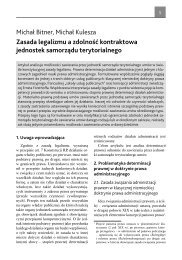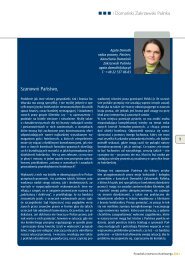Redundancy Law in Europe - Poland
Redundancy Law in Europe - Poland
Redundancy Law in Europe - Poland
You also want an ePaper? Increase the reach of your titles
YUMPU automatically turns print PDFs into web optimized ePapers that Google loves.
POLAND<br />
Lukasz Kuczkowski<br />
1 OVERVIEW<br />
<strong>Redundancy</strong> schemes <strong>in</strong> <strong>Poland</strong> are subject to various labour law regulations, such<br />
as the Labour Code Act dated 26 June 1974 (the Labour Code), and the Special<br />
Terms of Term<strong>in</strong>at<strong>in</strong>g Employees’ Employment for Reasons Not Related to the<br />
Employees Act dated 13 March 2003 (the Act).<br />
In <strong>Poland</strong>, term<strong>in</strong>ation of an employment agreement is a complex issue, particularly<br />
<strong>in</strong> the case of <strong>in</strong>dividual dismissals. Polish courts have been play<strong>in</strong>g<br />
an <strong>in</strong>creas<strong>in</strong>gly important role <strong>in</strong> this field. As legal awareness of Polish employee<br />
rights has grown, Polish courts <strong>in</strong>creas<strong>in</strong>gly exercise judicial control over employment<br />
term<strong>in</strong>ation matters. Thus, whenever employment is term<strong>in</strong>ated (whether<br />
with respect to <strong>in</strong>dividual employees or a group of employees dismissed as part<br />
of a collective redundancy), one should consider not only the direct costs of the<br />
employment contract’s term<strong>in</strong>ation (remuneration for the notice period, monetary<br />
equivalent for outstand<strong>in</strong>g annual leave, additional benefits or mandatory severance<br />
pay), but also potential future (ma<strong>in</strong>ly f<strong>in</strong>ancial) burdens result<strong>in</strong>g from<br />
control exercised by courts over employment term<strong>in</strong>ation. Such burdens may be<br />
very high, depend<strong>in</strong>g on the extent of the redundancies. Therefore, it is necessary to<br />
duly prepare, from a legal po<strong>in</strong>t of view, the procedure of employment term<strong>in</strong>ation<br />
to m<strong>in</strong>imize the likelihood of such additional burdens.<br />
#2008 Kluwer <strong>Law</strong> International B.V., The Netherlands.<br />
Maarten van Kempen, Lisa Patmore, Michael Ryley, and<br />
Robert von Ste<strong>in</strong>au-Ste<strong>in</strong>rück (eds), <strong>Redundancy</strong>, pp. 171-182.
172 Lukasz Kuczkowski<br />
2 MAJOR LEGAL REGULATIONS<br />
2.1 TIMING<br />
2.1.1 Term<strong>in</strong>ation<br />
The Polish Labour Code provides for the follow<strong>in</strong>g methods of term<strong>in</strong>at<strong>in</strong>g an<br />
employment contract:<br />
– upon mutual agreement of the parties;<br />
– with notice; and<br />
– discipl<strong>in</strong>ary dismissal (without notice).<br />
These methods apply to employment contracts made for a non-fixed term, a trial<br />
period and a fixed term. In the last case, an employment contract made for a term<br />
exceed<strong>in</strong>g six months may be term<strong>in</strong>ated with notice provided that it stipulates<br />
such an option.<br />
2.1.1.1 Mutual Agreement<br />
The mutual agreement of the parties must be a mutual declaration of the employer’s<br />
and the employee’s will. It must be made <strong>in</strong> writ<strong>in</strong>g, but it need not <strong>in</strong>clude a<br />
justification. Hence, any potential subsequent judicial control of the employment<br />
term<strong>in</strong>ation is very limited. This is because generally, the employee may only<br />
challenge the effectiveness of his/her declaration of will (consent to term<strong>in</strong>ate<br />
the employment contract by mutual agreement of the parties) by demonstrat<strong>in</strong>g<br />
that he/she made the declaration without full consent, such as by hav<strong>in</strong>g been<br />
threatened or misled. The court does not exam<strong>in</strong>e the actual reason for the term<strong>in</strong>ation<br />
of the employment contract. Hence, term<strong>in</strong>ation of an employment contract<br />
by mutual agreement of the parties is the most desirable form of term<strong>in</strong>at<strong>in</strong>g<br />
employment (from the employer’s perspective).<br />
2.1.1.2 Unilateral Term<strong>in</strong>ation<br />
Term<strong>in</strong>ation of employment with notice or without notice (discipl<strong>in</strong>ary dismissal)<br />
is effected by the employer’s unilateral declaration of will aimed at term<strong>in</strong>at<strong>in</strong>g an<br />
employee’s employment. The employer’s declaration should meet the follow<strong>in</strong>g<br />
formal requirements:<br />
– It should be executed <strong>in</strong> writ<strong>in</strong>g.<br />
– It should clearly and precisely specify to the employee the reason, which<br />
should be actual and justified, for the employment term<strong>in</strong>ation (this does not<br />
apply to contracts made for a fixed term).<br />
– It should <strong>in</strong>clude an <strong>in</strong>struction about the possibility of challeng<strong>in</strong>g the<br />
term<strong>in</strong>ation at a labour court and name the competent court.
<strong>Poland</strong> 173<br />
The declaration should be handed to the employee. The employee is neither<br />
required to acknowledge its receipt by sign<strong>in</strong>g it, nor even to read it. It is sufficient<br />
for the employer to provide the employee with the opportunity of acqua<strong>in</strong>t<strong>in</strong>g<br />
himself with the written declaration (such as by plac<strong>in</strong>g it <strong>in</strong> front of the employee).<br />
It must be emphasized that, whether or not it meets the above formal requirements,<br />
the notice is effective; that is, it leads to the term<strong>in</strong>ation of the employment<br />
contract. Hence, even if the written notice does not <strong>in</strong>clude the reason for term<strong>in</strong>ation,<br />
for example, the employment is term<strong>in</strong>ated.<br />
2.1.2 Notice Periods<br />
In the event of standard term<strong>in</strong>ation, an employment contract is term<strong>in</strong>ated only<br />
after the notice period ends. The statutory notice period is laid down <strong>in</strong> Articles 33<br />
and 34 of the Labour Code and depends on the length of the employee’s service<br />
with a given employer (except an employment contract for a fixed term):<br />
– In the case of contracts made for a trial period, the notice period is (i) three<br />
bus<strong>in</strong>ess days, if the trial period is up to two weeks; (ii) one week, if the trial<br />
period is longer than two weeks but shorter than three months; and (iii) two<br />
weeks, if the trial period is three months.<br />
– In the case of contracts made for a fixed term, the notice period is two<br />
weeks. However, this applies only to contracts made for a term exceed<strong>in</strong>g<br />
six months and provided that the contract may be term<strong>in</strong>ated with notice.<br />
Contracts for a fixed term of less than six months and those for a term<br />
exceed<strong>in</strong>g six months, which do not provide for term<strong>in</strong>ation by notice,<br />
may not be so term<strong>in</strong>ated.<br />
– In the case of contracts that are not for a non-fixed term, the notice period is:<br />
(i) two weeks, if the employee has been work<strong>in</strong>g for the employer for less<br />
than six months; (ii) one month, if the employee has been work<strong>in</strong>g for the<br />
employer for more than six months but less than three years; and (iii) three<br />
months, if the employee has been work<strong>in</strong>g for the employer for more than<br />
three years.<br />
2.1.3 Collective Redundancies<br />
2.1.3.1 Scope of Collective Redundancies<br />
In <strong>Poland</strong>, collective redundancies are governed by the Special Terms of Term<strong>in</strong>at<strong>in</strong>g<br />
Employees’ Employment for Reasons Not Related to the Employees<br />
Act, dated 13 March 2003, which implements Directive 98/59. The Act applies<br />
to employers of twenty or more employees. It is irrelevant whether the employees<br />
are engaged by the employer on a full- or a part-time basis. The type of the<br />
employment contract between an employee and the employer (for example, a<br />
contract for a fixed or non-fixed term, trial period or replacement) is not relevant.
174 Lukasz Kuczkowski<br />
The Act applies to both private employers and public employers funded by the<br />
State Treasury. The Act applies only if the employment contract is term<strong>in</strong>ated for<br />
a reason unrelated to an employee. Typical <strong>in</strong>stances <strong>in</strong>clude restructur<strong>in</strong>g or<br />
reduction of the number of jobs at the employer’s company, comb<strong>in</strong>ed with their<br />
liquidation.<br />
The provisions of the Act must be observed <strong>in</strong> the case of term<strong>in</strong>ation of<br />
employment by an employer of at least twenty employees for reasons not related<br />
to employees, if with<strong>in</strong> a maximum of thirty days, the redundancy applies to<br />
at least:<br />
– ten employees, if the employer employs less than 100 employees,<br />
–10% of employees, if the employer employs a m<strong>in</strong>imum of 100, but less<br />
than 300 employees,<br />
– thirty employees, if the employer employs a m<strong>in</strong>imum of 300 employees.<br />
In establish<strong>in</strong>g whether a given case <strong>in</strong>volves a collective redundancy, the manner<br />
of term<strong>in</strong>at<strong>in</strong>g employment is irrelevant as long as employment is term<strong>in</strong>ated for<br />
reasons not related to employees. This means that employment may be term<strong>in</strong>ated<br />
with notice or by the mutual agreement of the parties. In the latter case, if the<br />
agreement is executed on the employer’s <strong>in</strong>itiative, the number of dismissed<br />
employees only <strong>in</strong>cludes cases where at least five employees are laid off by mutual<br />
agreement of the parties.<br />
2.1.3.2 Notifications<br />
The employer should notify the trade unions as well as the county labour office of<br />
the planned collective redundancies. If trade unions represent employees at the<br />
employer’s company, the employer must consult them about planned collective<br />
redundancies. The ma<strong>in</strong> purpose of such consultations is to avoid or reduce the<br />
scope of the collective redundancies and safeguard the <strong>in</strong>terests of the dismissed<br />
employees.<br />
The employer must <strong>in</strong>form the trade unions and the county labour office of: the<br />
reasons for the planned collective redundancies, the number of employees affected,<br />
the classification of such employees, the criteria for select<strong>in</strong>g such employees, the<br />
duration of the planned collective redundancies process, and methods of resolv<strong>in</strong>g<br />
employment issues related to the collective redundancies.<br />
As a result of consultations with trade unions, the parties should enter <strong>in</strong>to an<br />
agreement. Such agreement should set out the rules for carry<strong>in</strong>g out the collective<br />
redundancies, <strong>in</strong>clud<strong>in</strong>g redundancy criteria and the employer’s actions aimed at<br />
m<strong>in</strong>imiz<strong>in</strong>g the adverse consequences of the redundancies, the level of severance,<br />
and so forth. The agreement should be entered <strong>in</strong>to with<strong>in</strong> twenty days of the<br />
<strong>in</strong>formation referred to above be<strong>in</strong>g provided to the trade unions.<br />
If two or more trade unions operate at a given employer’s company, the<br />
employer should hold consultations and enter <strong>in</strong>to an agreement with all the<br />
trade unions. If this proves impossible, the agreement should be executed with<br />
representative trade unions with<strong>in</strong> the mean<strong>in</strong>g of the Polish Labour Code.
<strong>Poland</strong> 175<br />
Follow<strong>in</strong>g this, the employer should notify the county labour office of the<br />
agreement executed with the trade unions and govern<strong>in</strong>g the collective redundancies<br />
or collective redundancy by-laws implemented by the employer (<strong>in</strong>dependently<br />
or upon agreement with the employee representative). This second notice should<br />
specify the scope of the redundancies, among other th<strong>in</strong>gs.<br />
2.1.3.3 Carry<strong>in</strong>g out the Redundancies<br />
Only after the employer has notified the county labour office of the extent of the<br />
collective redundancies and arrangements made follow<strong>in</strong>g consultations may the<br />
employer start dismiss<strong>in</strong>g <strong>in</strong>dividual employees by giv<strong>in</strong>g them notice or execut<strong>in</strong>g<br />
agreements concern<strong>in</strong>g term<strong>in</strong>ation of employment. Notice of employment term<strong>in</strong>ation<br />
may be given and employment may end thirty days after the county labour<br />
office has been given the second notice at the earliest.<br />
Dismissals as part of collective redundancies follow the rules applicable to<br />
standard dismissals. Thus, the same notice periods apply, the notice should meet<br />
specific legal requirements, and the employer should issue an employment certificate<br />
to the dismissed employee.<br />
The fact of a collective redundancies is no basis for the employer to shorten<br />
notice periods unilaterally, even when provid<strong>in</strong>g compensation. General rules<br />
apply <strong>in</strong> such cases. Accord<strong>in</strong>g to these rules, the employer may unilaterally shorten<br />
the notice period to one month if the reason for the redundancy is the liquidation or<br />
bankruptcy of the employer.<br />
Generally, the employer may commence dismissals as part of collective<br />
redundancies thirty days after the second notification to the county labour office<br />
at the earliest.<br />
2.2 INFORMATION AND CONSULTATION<br />
2.2.1 Individual <strong>Redundancy</strong><br />
2.2.1.1 Trade Unions<br />
Accord<strong>in</strong>g to Article 38 of the Labour Code, if trade unions operate at the employer’s<br />
company, the employer must consult them about the <strong>in</strong>tended term<strong>in</strong>ation of<br />
employment with or without notice <strong>in</strong> the follow<strong>in</strong>g two cases:<br />
– if the dismissed employee is a member of a trade union; or<br />
– if a trade union agreed to defend a given employee (who is not a union<br />
member).<br />
In these cases, the employer must notify the trade union of the <strong>in</strong>tention to term<strong>in</strong>ate<br />
the employment contract and must specify the reason for its term<strong>in</strong>ation. The<br />
trade union may express its op<strong>in</strong>ion on this matter with<strong>in</strong> five days. The op<strong>in</strong>ion<br />
is not b<strong>in</strong>d<strong>in</strong>g on the employer and even if it is negative, the employer may
176 Lukasz Kuczkowski<br />
nonetheless term<strong>in</strong>ate employment. If the above time limit expires and the<br />
employer does not receive any op<strong>in</strong>ion, it may proceed to term<strong>in</strong>ate employment.<br />
It must be emphasized that the consultation requirement only applies to nonfixed<br />
term contracts.<br />
2.2.1.2 Works Council<br />
In the event of dismiss<strong>in</strong>g <strong>in</strong>dividual employees, the employer is not required to<br />
consult the employee council about the <strong>in</strong>tended term<strong>in</strong>ation of employment.<br />
2.2.2 Collective Redundancies<br />
The ma<strong>in</strong> obligation of an employer <strong>in</strong>tend<strong>in</strong>g to carry out collective redundancies<br />
is to consult employees’ representatives about its <strong>in</strong>tention. The scope and b<strong>in</strong>d<strong>in</strong>g<br />
force of such consultations depend on the type of organization represent<strong>in</strong>g<br />
employees at the employer’s company; this may be a trade union, a works council<br />
or a representative elected by employees.<br />
2.2.2.1 Trade Unions<br />
Consultations with trade unions <strong>in</strong>clude the follow<strong>in</strong>g stages:<br />
(a) All trade unions represented at the employer’s company are <strong>in</strong>formed<br />
of the <strong>in</strong>tended collective redundancies. Such <strong>in</strong>formation should be<br />
provided to trade unions <strong>in</strong> writ<strong>in</strong>g <strong>in</strong> advance (namely, before the planned<br />
commencement of collective redundancies), so that it is possible to enter<br />
<strong>in</strong>to an agreement govern<strong>in</strong>g the collective redundancies with the trade<br />
unions. As part of perform<strong>in</strong>g that obligation, the employer <strong>in</strong>forms the<br />
trade unions about the reasons for the planned collective redundancies, the<br />
number of employees affected by them and the professional groups such<br />
employees belong to, the criteria for select<strong>in</strong>g such employees, the duration<br />
of the planned collective redundancies, the way of resolv<strong>in</strong>g employment<br />
issues related to the collective redundancies (such as the level of<br />
severance or professional tra<strong>in</strong><strong>in</strong>g) and so forth.<br />
(b) The trade unions make proposals concern<strong>in</strong>g the planned collective redundancy<br />
<strong>in</strong> connection with the above <strong>in</strong>formation provided by the employer.<br />
(c) The employer and the trade unions hold consultations and, consequently,<br />
enter <strong>in</strong>to an agreement govern<strong>in</strong>g the planned collective redundancies.<br />
The parties should hold consultations <strong>in</strong> good faith, namely, with the<br />
<strong>in</strong>tention of reach<strong>in</strong>g an agreement.<br />
2.2.2.2 Employee Representative<br />
If there are no trade unions operat<strong>in</strong>g at the employer’s company, trade union<br />
rights related to the collective redundancy procedure are available to an employee<br />
representative elected by employees <strong>in</strong> the manner adopted at the employer’s
<strong>Poland</strong> 177<br />
company. Such employee representative may not be imposed upon employees by<br />
the employer; he/she must be elected by employees themselves.<br />
The employer must <strong>in</strong>form the employee representative about the planned<br />
collective redundancies <strong>in</strong> the same way as applies to trade unions. The employee<br />
representative may make proposals related to <strong>in</strong>formation provided by the<br />
employer. The purpose of the consultations is to agree on collective redundancy<br />
by-laws with the employee representative.<br />
2.2.2.3 Works Council<br />
Whether or not trade unions operate at the employer’s company, the employer<br />
must also consult a works council about the planned collective redundancies,<br />
provided that such a council exists at the employer’s company. It may be<br />
created by employees or trade unions accord<strong>in</strong>g to the Employee Information<br />
and Consultation Act dated 7 April 2006 (this Act implements Directive 2002/<br />
14 <strong>in</strong> the Polish legal system). At present, only an employer with a workforce of<br />
at least a 100 employees must <strong>in</strong>form employees that they may create a works<br />
council.<br />
The consultation obligation results from the fact that a works council should<br />
be consulted about, among other th<strong>in</strong>gs, the employer’s planned changes to the<br />
employment level. Collective redundancies undoubtedly represent such a change.<br />
Consultations with the works council should precede the planned commencement<br />
of the collective redundancies. They are aimed, by analogy with consultations<br />
with trade unions, at m<strong>in</strong>imiz<strong>in</strong>g the adverse consequences of collective redundancies;<br />
however, their effects are not b<strong>in</strong>d<strong>in</strong>g on the employer.<br />
2.2.2.4 By-laws<br />
If the employer carries out consultations with trade unions but the two parties do<br />
not agree on the word<strong>in</strong>g of the agreement, the employer must unilaterally determ<strong>in</strong>e<br />
by-laws <strong>in</strong> relation to the collective redundancies, reflect<strong>in</strong>g, as far as<br />
possible, representations made by the trade unions dur<strong>in</strong>g consultations.<br />
The employer should also implement collective redundancy by-laws if there<br />
are no trade unions at the employer’s company, and <strong>in</strong> situations where consultations<br />
are held with the employee representative. In such cases, the employer should<br />
agree on the substance of the by-laws with the employee representative.<br />
2.3 RISKS<br />
2.3.1 Individual <strong>Redundancy</strong><br />
2.3.1.1 Unfair Dismissal<br />
In connection with term<strong>in</strong>ation of his/her employment with or without notice<br />
(discipl<strong>in</strong>ary dismissal), an employee is entitled to judicial control of such
178 Lukasz Kuczkowski<br />
term<strong>in</strong>ation. As part of this entitlement, an employee may sue his/her employer and<br />
claim re<strong>in</strong>statement or compensation. Judicial control is <strong>in</strong>stituted upon request, by<br />
way of a statement of claim, by the employee. As part of such control, the court<br />
exam<strong>in</strong>es both whether formal requirements were met concern<strong>in</strong>g the employer’s<br />
declaration of will to term<strong>in</strong>ate the employment contract, and whether the reason for<br />
the employment contract term<strong>in</strong>ation, as it appears <strong>in</strong> the declaration, is actual,<br />
specific, clear, and justified.<br />
The ma<strong>in</strong> risk an employer faces <strong>in</strong> relation to an <strong>in</strong>dividual redundancy is<br />
that an employee will br<strong>in</strong>g an action to a labour court claim<strong>in</strong>g re<strong>in</strong>statement<br />
or compensation. An employee may lodge such a claim primarily if he/she concludes<br />
that the reason for employment term<strong>in</strong>ation is untrue, as well as where the<br />
employer violated general rules concern<strong>in</strong>g <strong>in</strong>dividual redundancy (for example,<br />
the term<strong>in</strong>ation notice did not <strong>in</strong>clude all mandatory elements). Depend<strong>in</strong>g on<br />
its f<strong>in</strong>d<strong>in</strong>gs, the court may re<strong>in</strong>state the employee or award compensation (<strong>in</strong><br />
pr<strong>in</strong>ciple, equal to a maximum of three months’ salary; the compensation level is<br />
def<strong>in</strong>ed by the Labour Code and the court may only award such compensation up to<br />
this maximum level).<br />
2.3.1.2 Consequences of the Employer’s Failure to Follow<br />
the Procedure<br />
Polish laws do not guarantee the cont<strong>in</strong>uity of employment <strong>in</strong> the event that the<br />
employer breaches the Polish Labour Code provisions concern<strong>in</strong>g employee dismissals.<br />
Thus, even if the employer fails to follow the applicable procedure but<br />
communicates its <strong>in</strong>tention to dismiss an employee to such employee <strong>in</strong> any way,<br />
employment is effectively term<strong>in</strong>ated under law. The effects, namely, term<strong>in</strong>ation<br />
of employment, may only be mitigated if the employee br<strong>in</strong>gs an action to a labour<br />
court and is re<strong>in</strong>stated. However, <strong>in</strong> pr<strong>in</strong>ciple, if the employee does not take such<br />
action, employment will not be automatically restored.<br />
2.3.1.3 Notice Restrictions<br />
Some employees are protected aga<strong>in</strong>st <strong>in</strong>dividual redundancies, and thus their<br />
employment contracts may not be term<strong>in</strong>ated with notice. In pr<strong>in</strong>ciple, however,<br />
such protection does not apply <strong>in</strong> the event of discipl<strong>in</strong>ary dismissals.<br />
Protected employees <strong>in</strong>clude, for <strong>in</strong>stance: trade union activists; pregnant<br />
women; employees tak<strong>in</strong>g annual, maternity, child-rais<strong>in</strong>g, and sick leave; members<br />
of a work council; and employees with less than four years rema<strong>in</strong><strong>in</strong>g until<br />
retirement age. Nonetheless, it must be emphasized that if the employer violates<br />
these protection rules, for example by term<strong>in</strong>at<strong>in</strong>g an employment contract with a<br />
pregnant woman by giv<strong>in</strong>g notice, the term<strong>in</strong>ation is effective. However, if the<br />
dismissed employee <strong>in</strong> question br<strong>in</strong>gs an action to court, the likelihood that he/she<br />
will be re<strong>in</strong>stated is very high.
<strong>Poland</strong> 179<br />
2.3.2 Collective Redundancies<br />
2.3.2.1 Selection Criteria<br />
Generally, the employer determ<strong>in</strong>es the selection criteria concern<strong>in</strong>g employees<br />
to be dismissed dur<strong>in</strong>g collective redundancies itself. Such criteria should be<br />
objective, so that the employer does not violate the laws prohibit<strong>in</strong>g discrim<strong>in</strong>ation<br />
<strong>in</strong> employment. Dur<strong>in</strong>g consultations with trade unions, the works council and<br />
employee representatives, the employer may change these criteria or set new ones.<br />
2.3.2.2 Unfair Dismissal<br />
A collective redundancy does not preclude an unfair dismissal, s<strong>in</strong>ce it cannot be<br />
guaranteed that the reason for the collective redundancy, as given by the employer,<br />
is based on fact. In such cases, the employee’s entitlements are identical to those<br />
available <strong>in</strong> the event of collective redundancies (compare to section 2.3.1.1<br />
above).<br />
2.3.2.3 Notice Restrictions<br />
In general, various provisions afford<strong>in</strong>g employees special protection aga<strong>in</strong>st<br />
term<strong>in</strong>ation of employment with notice or otherwise do not apply to collective<br />
redundancies. In pr<strong>in</strong>ciple, the employer is not obligated to consult trade<br />
unions regard<strong>in</strong>g the <strong>in</strong>tention to dismiss any <strong>in</strong>dividual employee (if an agreement<br />
with trade unions was entered <strong>in</strong>to). Additionally, the employer enjoys greater<br />
freedom to dismiss an employee who is absent due to annual leave or for other<br />
valid reasons.<br />
Some employee groups, though protected <strong>in</strong> the event of <strong>in</strong>dividual redundancies,<br />
are not protected aga<strong>in</strong>st collective redundancies. These <strong>in</strong>clude employees<br />
who are absent due to annual leave or for other justified reasons, as well as<br />
those who are four years away from retirement age.<br />
On the other hand, the employer may not give notice of employment term<strong>in</strong>ation<br />
as part of collective redundancies to other employees who enjoy special<br />
protection, such as trade unionists, members of an employee council or pregnant<br />
women. In such cases, <strong>in</strong> the event of collective redundancies, the employer may<br />
only term<strong>in</strong>ate terms of work and pay, subject to the proviso that if such employees’<br />
salaries are reduced, they are entitled to receive a compensatory benefit by the<br />
end of the protection period.<br />
2.3.2.4 Re-employment<br />
An employee dismissed as part of collective redundancies may notify the employer<br />
about his/her will<strong>in</strong>gness to be re-employed if the employer hires new employees.<br />
Such notice should be given <strong>in</strong> writ<strong>in</strong>g with<strong>in</strong> a year of the end of employment.
180 Lukasz Kuczkowski<br />
If such notice is given, the employer must re-employ the dismissed employee if it<br />
hires employees <strong>in</strong> the professional group to which the dismissed employee<br />
belongs. This obligation applies to the employer for a period of fifteen months<br />
follow<strong>in</strong>g the end of the employee’s employment. Once such a period has elapsed,<br />
the employer is no longer obligated to re-employ the dismissed employee.<br />
The purpose of such regulation is to m<strong>in</strong>imize the number of cases where the<br />
employer carries out collective redundancies and shortly thereafter hires new<br />
employees for the same positions but usually at lower salaries.<br />
If the employer does not re-employ the dismissed employee despite meet<strong>in</strong>g<br />
the statutory requirements (notice and time limit), the dismissed employee may<br />
claim re-employment by the employer <strong>in</strong> court.<br />
2.3.2.5 Consequences of the Employer’s Failure to Follow<br />
the Procedure<br />
The employer’s failure to follow the collective redundancy procedure does not<br />
entitle an employee to lodge a claim for re<strong>in</strong>statement or a compensation payment.<br />
However, if the employer fails to follow the collective redundancy procedure, the<br />
employer (management board members or other people <strong>in</strong> charge) may be f<strong>in</strong>ed by<br />
a labour <strong>in</strong>spector.<br />
2.3.2.6 Discrim<strong>in</strong>ation<br />
Anti-discrim<strong>in</strong>ation legislation affects the collective redundancy procedure only<br />
as regards to sett<strong>in</strong>g the criteria for selection of the employees to be dismissed.<br />
Such criteria may not violate the laws prohibit<strong>in</strong>g discrim<strong>in</strong>ation <strong>in</strong> employment.<br />
Therefore, such criteria should be objective.<br />
If non-objective criteria violat<strong>in</strong>g the laws prohibit<strong>in</strong>g discrim<strong>in</strong>ation are set<br />
down, the employee dismissed on the basis of such criteria may be awarded compensation<br />
of not less than the national m<strong>in</strong>imum wage (<strong>in</strong> 2007, this was about<br />
EUR 250). The Labour Code does not specify any compensation cap.<br />
2.4 COSTS<br />
2.4.1 Individual <strong>Redundancy</strong><br />
Individual redundancy costs generally <strong>in</strong>clude: (i) the costs of remuneration paid<br />
to the employee dur<strong>in</strong>g the notice period (employees often submit medical<br />
exemptions from work and do not work dur<strong>in</strong>g such period), and (ii) the costs<br />
of a monetary equivalent of any leave not taken, if the employee is still entitled to<br />
such leave at the end of the notice period.<br />
Some provisions of the Act also apply if, though collective redundancies do<br />
not take place (due to a small number of dismissed employees), the reasons for<br />
term<strong>in</strong>at<strong>in</strong>g a given employee’s employment with notice or by mutual agreement
<strong>Poland</strong> 181<br />
of the parties are related to the employer only. In such cases, the employer must pay<br />
statutory severance pay to the dismissed employee. For the severance pay level, see<br />
section 2.4.2.1 below.<br />
2.4.2 Collective Redundancies<br />
2.4.2.1 Mandatory Compensation<br />
The employer’s ma<strong>in</strong> obligation related to collective redundancies result<strong>in</strong>g from<br />
Article 8 of the Act is to pay statutory severance pay to the dismissed employees.<br />
The severance level depends on the dismissed employee’s length of service, but<br />
may not exceed fifteen times the national m<strong>in</strong>imum wage applicable <strong>in</strong> a given<br />
calendar year (the national m<strong>in</strong>imum wage changes every calendar year). Thus, <strong>in</strong><br />
2007, statutory severance pay could not exceed approximately EUR 3,500.<br />
The level of severance pay available is as follows:<br />
(a) one month’s salary, if the employee has been employed with the employer<br />
for less than two years;<br />
(b) two months’ salary, if the employee has been employed with the employer<br />
for more than two years and less than eight years;<br />
(c) three months’ salary, if the employee has been employed with the<br />
employer for more than eight years.<br />
The employer may not reduce such statutory severance pay. Severance pay is paid<br />
when employment ends.<br />
2.4.2.2 Social Plan<br />
The employer is free to grant additional benefits to dismissed employees. These<br />
benefits may be monetary (such as premiums, bonuses, or additional severance<br />
pay) and non-monetary (such as professional tra<strong>in</strong><strong>in</strong>g courses and sessions). Such<br />
additional benefits may be granted by the employer on a discretionary basis,<br />
unless they are granted under an agreement or by-laws determ<strong>in</strong>ed follow<strong>in</strong>g<br />
consultations.<br />
3 ADVICE FOR LEGAL PRACTICE<br />
3.1 INDIVIDUAL REDUNDANCIES<br />
3.1.1 Tim<strong>in</strong>g<br />
The ma<strong>in</strong> issues as regards <strong>in</strong>dividual redundancies are whether the formal requirements<br />
were met concern<strong>in</strong>g the substance of the employer’s declaration of will to<br />
term<strong>in</strong>ate an employment contract, and whether there is a specific, actual, clear, and<br />
justified reason for term<strong>in</strong>ation of an employee’s employment. If these fundamental
182 Lukasz Kuczkowski<br />
rules are violated, the employer usually loses <strong>in</strong> a court action <strong>in</strong> which the employment<br />
contract term<strong>in</strong>ation is controlled by the court.<br />
3.1.2 Risks<br />
The ma<strong>in</strong> risk to the employer <strong>in</strong> the event of <strong>in</strong>dividual redundancies is that an<br />
employee will be re<strong>in</strong>stated or awarded compensation. This risk cannot be fully<br />
elim<strong>in</strong>ated, but it can be reduced considerably, provided that the term<strong>in</strong>ation of the<br />
employment contract is duly prepared <strong>in</strong> legal terms. However, Polish employees<br />
are <strong>in</strong>creas<strong>in</strong>gly aware of their rights <strong>in</strong> this respect, and thus they request labour<br />
courts to exam<strong>in</strong>e employment term<strong>in</strong>ation more and more frequently.<br />
3.2 COLLECTIVE REDUNDANCIES<br />
3.2.1 Tim<strong>in</strong>g<br />
The most important issues related to collective redundancies are tim<strong>in</strong>g and the<br />
execution of an agreement with trade unions, or the determ<strong>in</strong>ation of by-laws with<br />
an employee representative. If the employer reaches this stage of the collective<br />
redundancy procedure swiftly, the procedure may be shortened and the redundancies<br />
themselves may take place earlier. However, s<strong>in</strong>ce third parties (trade unions<br />
or an employee representative) are <strong>in</strong>volved, sometimes the time needed to<br />
complete the collective redundancy procedure cannot be shortened, regardless<br />
of how well prepared the employer was. Where this is the case, there are often<br />
additional costs to the employer whilst be<strong>in</strong>g obliged to ma<strong>in</strong>ta<strong>in</strong> the exist<strong>in</strong>g level<br />
of employment.<br />
3.2.2 Costs<br />
When plann<strong>in</strong>g collective redundancies, one should primarily take <strong>in</strong>to account<br />
costs of additional severance pay, which render such redundancies much more<br />
expensive. Additionally, one should consider the costs of potential court claims<br />
by employees challeng<strong>in</strong>g their dismissal. If the reasons for collective redundancies<br />
are well justified <strong>in</strong> legal and economic terms, the likelihood that such a claim<br />
will be resolved to the benefit of the employee is small, but it cannot be fully<br />
disregarded due to the complex redundancy procedure and the risk of the employer<br />
hav<strong>in</strong>g made an error.<br />
The employer’s liability is essentially limited to f<strong>in</strong>ancial liability <strong>in</strong> connection<br />
with employee claims. If redundancies are duly prepared, this liability may be<br />
m<strong>in</strong>imized.


